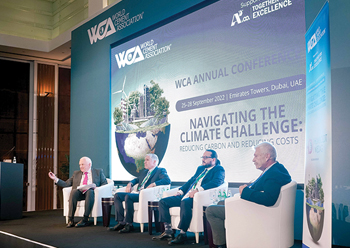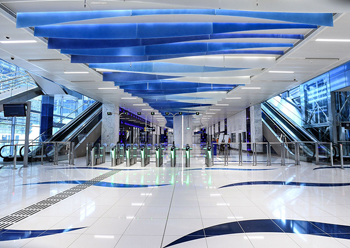
It’s time for the whole industry to move on from “we need to...” to take concrete steps to ensure the decarbonisation of cement and concrete based on alternative fuels and raw (AFR) materials, declared delegates at the conclusion of the recent CarbonZero Global Conference and Exhibition held in Portugal.
The two-day event, held from November 10, brought together top experts to find and outline the most effective solutions for decarbonising the cement industry which is responsible for almost eight per cent of carbon dioxide (CO2) emissions. The topics that make the agenda of the biggest cement and construction companies worldwide and the latest developments and challenges in product manufacturing and technology applications were discussed at the forum on Alternative Fuels and Raw Materials at the Pestana Palace Hotel & National Monument, Lisbon.
“The circular economy is a real thing the industry should tend towards. And today’s waste should be turned into tomorrow’s raw material,” they declared.
Among the delegates, Dr Edelio Bermejo, Head of Group R&D and IP at Holcim, explained the way the global leader in sustainable building solutions dedicates more than 80 per cent of its innovation resources to developing sustainable products and solutions and recently launched ECOPlanet, its global range of green cement, which is said to deliver at least 30 per cent lower carbon footprint with equal to superior performance.
Ian Skocek, Global R&D of Heidelberg Materials, German Innovation Award for Climate and Environment Winner, explained the technological advances his company has made to enable 100 per cent recycling of concrete by reusing all constituents in the original materials.
He said: “Advanced concrete recycling and enforced carbonation enable complete circularity of concrete including the process CO2. By means of the energy-efficient selective separation, both recycled aggregates and sand can be reused in readymix concrete, preserving natural materials and shortening transport distances as recycling can be done close to the concrete customers. The fines produced can capture and mineralise CO2 from raw flue gas from the cement plant and the carbonated fines can be used in cement production as a highly reactive cementitious material. With our ReConcrete-360° concept, we have proven that concrete has the potential to be the most sustainable building product over its entire life cycle. Circularity of concrete, cement and CO2 is possible now.” n
Some ambitious decarbonisation goals for South Africa by increasing the utilisation of AFRs in the cement sector were highlighted by Dr Dhiraj Rama, the Industry Executive of Cement and Concrete South Africa. This can provide an appropriate response to decarbonisation as well as grow the circular economy.
Saurabh Palsania, the Group Commercial Head of Dalmia Cement, one of India’s most promising, fourth-largest cement companies, “Green Hero Award” winner, talked about the benefits of co-processing and explained how to support and serve waste generators for a clean future.
KHD, Firefly AB, Bedeschi, and SpectraFlow Analytics, the conference sponsors outlined the most effective solutions and technologies for several types of challenges regarding fire risks, handling, and storage of alternative fuels and raw materials.
Matthias Mersmann, CTO KHD Humboldt Wedag International, underlined interesting options to use different alternative fuels and raw materials and described the necessary process and equipment adaptations for the efficient decarbonising of the cement industry.
Mersmann stated: “There is no future without cement and there will be no cement without decarbonisation! Turning this challenge into opportunities requires cooperation and communication beyond our usual routines.”
Fabio Chignoli presented Bedeschi’s point of view on “Challenges in handling material” while looking for solutions to reduce the CO2 footprint of cement production.
In the same vein, fires are especially common in factories with an increased concentration of combustive materials, volatile substances, and equipment. Raúl Moreno, Director at Firefly Ab, presented solutions for this high-risk problem.
The solution to the fragility of the renewable energy supply, offered by Petra Muehlen, CEO of SpectraFlow Analytics, is to turn all kinds of waste into fuel. Realtime online Near Infrared (NIR) analysis not only provides the opportunity to minimise volumes of organic fuels by increasing the number of alternative fuels, but also maintains a high performance of the kilns, Muehlen stated.
Fokion Tasoulas, Executive Director of Titan Cement, also shared the idea that the cement industry can gain advantages in digital competition if it sees digitalisation as a driver of sustainability. To implement such a change of direction - in addition to strong collaboration between stakeholders, it requires a climate strategy, measurable goals, clearly defined action plans, and reporting that assesses the effectiveness of the measures.
Dr. Yianni Spanos, Director of Sustainability at KEO International Consultants, shared his experience in the development of sustainable real estate assets, low-carbon solutions, and urban development programmes in the Middle East and North Africa, the UK, Europe, and West Africa.
On the other hand, the energy crisis and geopolitical instabilities are pushing toward an innovative approach to critical minerals. Andrei Covatariu, the renowned international energy expert, stated that the past decades have witnessed an increase in environmental concerns, pushing national governments to invest in low-emission technologies, harvesting and efficiently using local natural potential.
Another angle of approach to use local natural potential was given by Francisco Leme, President of ABREN - the Brazilian Association for Energy Recovery of Waste. Leme shared Brazil’s perspective of refuse derived fuel (RDF) utilisation for carbon footprint lowering.
C+ executives and decision makers from cement manufacturing companies, equipment and technology producers as well as innovation, research and development and environmental professionals at the event all agreed that they need the support of authorities and regulators to change rules that are no longer in line with the current needs of the industry.








.jpg)




.jpg)




























.jpg)



































.jpg)
.jpg)